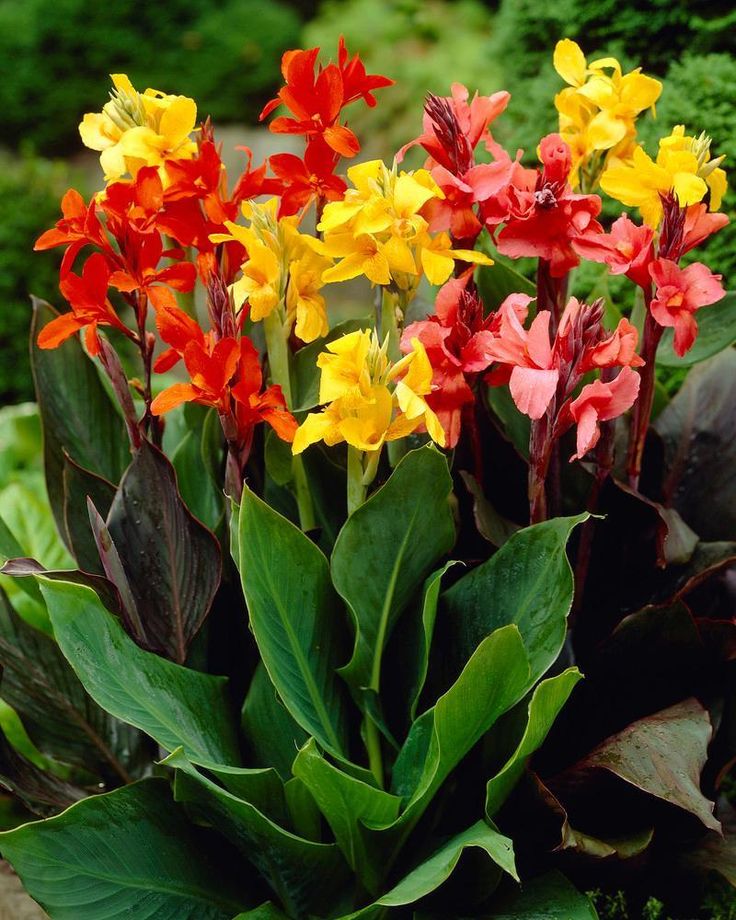Canna Lily (Canna x generalis)
'Cannova Bronze Orange' and
other varieties
Last
updated: August 3,
2025
Care Sheet List
Canna
'Cannova Bronze Orange' is a stunning tropical plant known for its
vibrant
bronze-red foliage and bright orange flowers. It brings a bold,
exotic feel to any garden or patio. While typically grown outdoors, in
colder
climates it's treated as an annual or the rhizomes are dug up for
winter
storage.
Lighting
Canna
'Cannova Bronze Orange' thrives in full sun,
meaning at least 6-8 hours
of direct sunlight per day. The more sun it
gets, the more vibrant
its foliage and blooms will be. It can tolerate partial sun (4-6 hours
of
direct sun), but flowering may be less prolific, and the bronze color
of the
leaves might be less intense.
Watering
Routine
Cannas are
thirsty plants and prefer consistently moist soil, especially during
their
active growing and blooming season (typically summer).
- For Plants in
Flower Beds: Water deeply
and regularly, especially during dry spells or hot weather. Aim to keep
the soil consistently moist but not waterlogged. Depending on your
climate and soil type, this might mean watering every 1-3 days during
peak summer.
- For Potted
Plants: Potted plants
dry out much faster than those in the ground.
You will likely need to water your potted Canna daily, especially on
hot, sunny days. Check the soil moisture frequently by sticking your
finger about an inch or two into the soil. Water until you see it
draining from the bottom of the pot. Ensure the pot has excellent
drainage.
Fertilizer
Requirements
Cannas are
heavy feeders and benefit from regular fertilization to support their
vigorous
growth and abundant blooms.
- Fertilizer Type: Use a balanced
all-purpose granular fertilizer (e.g., 5-10-5 or 10-10-10) or a liquid
fertilizer formulated for flowering plants.
- Commercial Recommendation: For granular, Osmocote
Smart-Release Plant Food Flower & Vegetable is a good
slow-release option. For liquid, Miracle-Gro
Water Soluble All-Purpose Plant Food is readily available and
effective. When using liquid commercial concentrates, aim for a "Moderate to Heavy Feeding" rate, achieving approximately 100-200 ppm N in your final solution.
- DIY Fertilizer Suggestion: For robust growth and abundant blooms, use your homemade 1-2-1 liquid fertilizer concentrate (High Phosphorus) or a balanced 1-1-1 liquid fertilizer concentrate.
- For 1-2-1 concentrate (10,000 ppm N): Apply at a "Heavy Feeding" rate, using 15 ml to 20 ml per 1 liter of water (resulting in ~150-200 ppm N). See recipe details.
- For 1-1-1 concentrate (10,000 ppm N): Apply at a "Heavy Feeding" rate, using 20 ml per 1 liter of water (resulting in ~200 ppm N). See recipe details.
- Schedule:
- In Flower Beds: Incorporate a
slow-release granular fertilizer into the soil at planting time.
For continuous feeding, you can apply a liquid fertilizer every 2-4
weeks during the growing season, or top-dress with a granular
fertilizer every 4-6 weeks, following product instructions.
- For Potted
Plants: Fertilize more
frequently, as nutrients leach out of pots faster.
Apply a liquid fertilizer every 2-3 weeks, or use a slow-release
granular fertilizer mixed into the potting mix at planting time (which
may last for several months).
Misting
Requirements
Misting is not
generally required nor beneficial for outdoor cannas. They
prefer to get
their moisture through their roots. High humidity from the surrounding
environment is usually sufficient if needed, but direct misting does
little for
the plant's overall hydration or health.
Pot Size
and Soil Type
- Pot Size (for
Potted Plants): Cannas grow
large, even the 'Cannova' series which is more compact. Choose a pot
that is at least 15-20 inches (38-50 cm) in diameter
for a single mature plant to allow for adequate root growth and to
prevent it from becoming top-heavy. Larger pots are always better for
cannas if space allows. Ensure the pot has excellent drainage
holes.
- Soil Type: Cannas prefer rich,
well-draining soil that retains some moisture.
- For Flower Beds: Amend your
garden soil with plenty of organic matter like compost or well-rotted
manure before planting. This improves drainage in heavy clay soils and
water retention in sandy soils.
- For Potted
Plants: Use a
high-quality, well-draining potting mix that is designed for
containers. You can enhance drainage and aeration by mixing in some
perlite or coarse sand (around 10-20% of the total volume). Avoid
heavy, dense potting soils that can become waterlogged.
Winter
Care (Important for Non-Tropical Climates)
Canna
'Cannova Bronze Orange' is typically hardy in USDA Zones 7-10.
- In Zones 7-10: In milder
climates, the rhizomes can often be left in the ground. Apply a thick
layer of mulch (4-6 inches) over the planting area in late fall to
provide insulation.
- In Zones 6 and
Colder: Cannas are
typically grown as annuals or their rhizomes (underground stems) need
to be dug up and stored indoors for the winter.
- After the first
frost (when foliage
turns brown), cut the stems back to about 4-6 inches above the ground.
- Carefully dig
up the rhizomes, being gentle to avoid damage.
- Brush off excess
soil (do not wash).
- Allow them to dry in a cool, airy
place for a few days until the outer skin is dry to the touch.
- Store them in a
cool (40-50°F / 4-10°C), dark, and dry location in a breathable
material like peat moss, vermiculite, or sawdust. Check periodically
for rot or shriveling.
- Replant them
outdoors after the
danger of the last frost has passed in spring.
Deadheading
To encourage
more blooms and maintain a tidy appearance, deadhead
spent flowers by
snipping off the individual faded blooms. Once
an entire flower
stalk has finished blooming, you can cut it down to the ground to allow
new
stalks to emerge.
By following
these guidelines, your Canna 'Cannova Bronze Orange' will provide a
spectacular
display of color and tropical flair throughout the summer!


